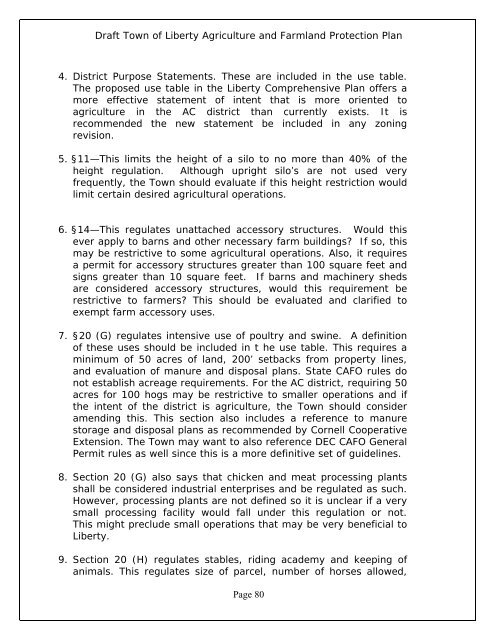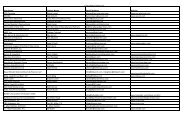Agriculture and Farmland Protection Plan - Town of Liberty
Agriculture and Farmland Protection Plan - Town of Liberty
Agriculture and Farmland Protection Plan - Town of Liberty
Create successful ePaper yourself
Turn your PDF publications into a flip-book with our unique Google optimized e-Paper software.
Draft <strong>Town</strong> <strong>of</strong> <strong>Liberty</strong> <strong>Agriculture</strong> <strong>and</strong> Farml<strong>and</strong> <strong>Protection</strong> <strong>Plan</strong><br />
4. District Purpose Statements. These are included in the use table.<br />
The proposed use table in the <strong>Liberty</strong> Comprehensive <strong>Plan</strong> <strong>of</strong>fers a<br />
more effective statement <strong>of</strong> intent that is more oriented to<br />
agriculture in the AC district than currently exists. It is<br />
recommended the new statement be included in any zoning<br />
revision.<br />
5. §11—This limits the height <strong>of</strong> a silo to no more than 40% <strong>of</strong> the<br />
height regulation. Although upright silo’s are not used very<br />
frequently, the <strong>Town</strong> should evaluate if this height restriction would<br />
limit certain desired agricultural operations.<br />
6. §14—This regulates unattached accessory structures. Would this<br />
ever apply to barns <strong>and</strong> other necessary farm buildings? If so, this<br />
may be restrictive to some agricultural operations. Also, it requires<br />
a permit for accessory structures greater than 100 square feet <strong>and</strong><br />
signs greater than 10 square feet. If barns <strong>and</strong> machinery sheds<br />
are considered accessory structures, would this requirement be<br />
restrictive to farmers? This should be evaluated <strong>and</strong> clarified to<br />
exempt farm accessory uses.<br />
7. §20 (G) regulates intensive use <strong>of</strong> poultry <strong>and</strong> swine. A definition<br />
<strong>of</strong> these uses should be included in t he use table. This requires a<br />
minimum <strong>of</strong> 50 acres <strong>of</strong> l<strong>and</strong>, 200’ setbacks from property lines,<br />
<strong>and</strong> evaluation <strong>of</strong> manure <strong>and</strong> disposal plans. State CAFO rules do<br />
not establish acreage requirements. For the AC district, requiring 50<br />
acres for 100 hogs may be restrictive to smaller operations <strong>and</strong> if<br />
the intent <strong>of</strong> the district is agriculture, the <strong>Town</strong> should consider<br />
amending this. This section also includes a reference to manure<br />
storage <strong>and</strong> disposal plans as recommended by Cornell Cooperative<br />
Extension. The <strong>Town</strong> may want to also reference DEC CAFO General<br />
Permit rules as well since this is a more definitive set <strong>of</strong> guidelines.<br />
8. Section 20 (G) also says that chicken <strong>and</strong> meat processing plants<br />
shall be considered industrial enterprises <strong>and</strong> be regulated as such.<br />
However, processing plants are not defined so it is unclear if a very<br />
small processing facility would fall under this regulation or not.<br />
This might preclude small operations that may be very beneficial to<br />
<strong>Liberty</strong>.<br />
9. Section 20 (H) regulates stables, riding academy <strong>and</strong> keeping <strong>of</strong><br />
animals. This regulates size <strong>of</strong> parcel, number <strong>of</strong> horses allowed,<br />
Page 80




